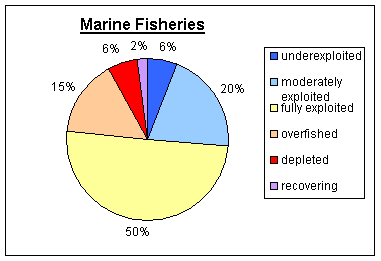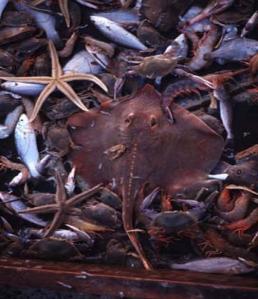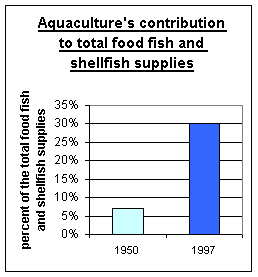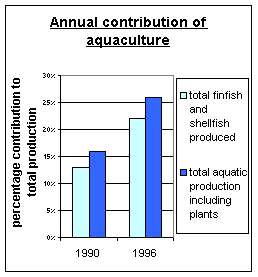
Home |
United Nations
System-Wide
Earthwatch |
||||||||||||
|
FOR AGENDA 21 CHAPTER 17 OCEANS AND COASTAL AREAS Widespread coral bleaching Coral reefs under pressure Coastal threats Crisis in ocean fisheries Small islands Widespread coral bleaching - updated to 3 November 2000 One effect of the shifts in ocean conditions produced by the El Niño/Southern Oscillation, possibly assisted by global warming, is the bleaching of corals and other animals on tropical coral reefs. Corals usually live near the upper limit of their temperature tolerance, and even a small increase in temperatures above their normal temperature limit can stress them and lead to the expulsion of their symbiotic algae, which give them their colors as well as providing nourishment. Corals can often recover from short bleaching events, but extended or repeated bleaching can be fatal. During the major El Niño in 1997-98, bleaching occurred on coral reefs ranging from Kenya to French Polynesia and Baja California in the Indo-Pacific, and from the Florida Keys to the Yucatan coast in the Caribbean. For instance, in the Maldives, a massive bleaching event was reported in May 1998. More than 90% of animals with algal symbionts, including corals, giant clams, anemones and soft corals showed heavy bleaching to depths of 20 metres at 8 locations on North Mahe atoll. Swimming up the reef was described as like going up the snowcapped Alps. Conditions at the time in the Maldives included surface water temperatures of 32 degrees C extending down to 15 metres, very low wind with no surface mixing, and a low tidal range of less than half a metre (Elder, 1998). Bleaching was also reported early in 1998 as starting in the southernmost part of the Australian Great Barrier Reef and moving northward, reaching New Caledonia. Corals in the Galapagos Islands bleached at temperatures of 29 degrees C, a degree and a half warmer than the critical temperature for bleaching at that site. Sea surface temperatures in the major El Niño events of the 1980s were not quite this warm (Strong, 1998). In the Caribbean on the Belize barrier reef, the largest in the Northern Hemisphere, sea surface temperatures, which rarely exceed 29 degrees C, reached 31.5 degrees and were greater than 30 degrees for months in 1998. This killed the most abundant coral on the reefs, Agaricia tenuifolia, causing the first recorded complete collapse of a coral population from bleaching in the Caribbean, and damaging other species, as demonstrated by surveys in 1999 and 2000. Coral cores from the reef showed that no similar bleaching had happened for more than 3,000 years (Aronson et al, 2000). This widespread bleaching on coral reefs, and other aspects of the state of coral reefs, are reviewed every two years in the Status of Coral Reefs of the World (Wilkinson, 1998; 2000). This information is being collected and updated by the Global Coral Reef Monitoring Network. A new episode of bleaching was reported in the mid-Pacific from mid-February to late April 2000, associated with La Niña, the reverse of El Niño. Hot spots ranging from the Solomon Islands to Easter Island measured 30-31.5 degrees C caused bleaching in 50 to 90 percent of the corals. For instance, in Fiji, up to 90 percent of corals bleached down to a depth of 30 metres. All coral species were affected, although some shallow water populations showed selective recovery (ICRI, 2000). A near-real-time chart of unusually warm sea surface temperatures associated with coral bleaching is available from US NOAA at http://psbsgi1.nesdis.noaa.gov:8080/PSB/EPS/SST/climohot.html .
Coral reefs under pressure - updated to 14 August 2001 In addition to the short-term threat represented by coral bleaching, coral reefs are under pressure from a variety of human impacts. The accelerating decline of coral reef ecosystems is described in the latest global assessment of the Status of Coral Reefs of the World: 2000 (Wilkinson, 2000). It details the continuing deterioration of coral reefs in all areas where human activities are concentrated, notably along the coast of eastern Africa, all of continental South Asia, throughout Southeast and East Asia and across the wider Caribbean region. It shows that by late 2000, 27% of the
world’s reefs have been effectively lost, with the
The extent of world-wide degradation of reefs was first documented by a global survey undertaken by Reef Check 1997 (http://www.ust.hk/~webrc/ReefCheck/summary.html). Many coral reef fisheries resources are being pushed towards extinction everywhere by heavy over-exploitation, and habitat degradation from land-based activities and runoff is widespread on inhabited coasts. The first global assessment of coral reefs to map areas at risk from overfishing, coastal development and other human activity (Bryant et al., 1998), shows threats to 58 percent of the world's coral reefs. A third of all reefs are threatened by overexploitation, and a third also by coastal development. At least 11 percent are "hot spots" with high levels of reef fish biodiversity that are under high threat from human activities, including Philippine and Indonesian reefs, Tanzania and the Comoros along the East African coast, and the Lesser Antilles in the Caribbean. In Southeast Asia, more than 80 percent of the most species-rich coral reefs on earth are threatened by coastal development and fishing pressures, and over half are at high risk. Nearly two thirds of Caribbean reefs are in jeopardy, especially around islands like Jamaica, Barbados and Dominica. Pacific reefs are the least threatened, with only 40 percent at medium or high risk of damage. While there are over 400 marine parks and reserves with coral reefs, most are very small, and at least 40 countries have no protected areas for their coral reefs (http://www.wri.org/wri/indictrs/reefrisk.htm). Another concern is the recent discovery that coral reefs are threatened by rising levels of carbon dioxide in the atmosphere, which may lower calcification rates of corals, coralline algae and coral-algal communities by up to 10-20 percent as carbon dioxide levels double in the next century. (Coral Reefs and Global Change,1998) This will make it harder for them to build their skeletons and add to the reef. Other estimates suggest that the increase in atmospheric CO2 will reduce carbonate ion concentration in the surface ocean by 30percent and cause a potential reduction in coral growth over the next 65 years of 40 percent (Langdon, 2000). More general information on the status of coral reefs is available from the NOAA Coral Health and Monitoring Project at http://coral.aoml.noaa.gov/ .
Coastal threats - updated to 15 August 1998 New calculations show that 37 percent of the world's population live within 100 kilometres of the coast (Cohen et al., 1997). Since the coastal 100 kilometre strip represents 18.7% of the total land area (27,491,108 km2 out of 146,874,796 km2)(Dao, 1998), the average human population density in coastal areas is about 80 persons per square kilometre, twice the global average. Considering that many coastlines are sparsely populated or uninhabited (Antarctica, the far North, etc.), the actual population pressure on the coast in more habitable areas is very high. A recent global assessment of the risks of coastal degradation from development-related activities shows that 34 percent of the world's coasts are at high risk and another 17 percent at medium risk. The most threatened regions are Europe with 86 percent and Asia with 69 percent of their coastal ecosystems at risk (WRI/UNEP/UNDP/WB, 1996). The international response to this growing risk to ocean resources has been the adoption of the Global Programme of Action for the Protection of the Marine Environment from Land-based Activities at the Washington Conference in November 1995 (UNEP, 1995). New uses of the sea such as deep mineral exploitation will also create environmental impacts that need to be anticipated.
Crisis in ocean fisheries - updated 28 July 2000 The collapse of the North-west Atlantic cod fishery, among other ocean fishery crises and disputes, has only confirmed the concerns behind the oceans chapter of Agenda 21 (UNCED, 1992, para. 17.45 and 17.72). World fishery production has reached 122 million tones in 1997, a figure six times that of 1950 (FAO Fact File). Major ocean fisheries, most of which are within exclusive economic zones, are already using a high proportion of the total available primary production, amounting to 25 percent for upwelling areas and 24-35 percent in shelf systems, leaving little or no possibility for further increases in these most productive fisheries (Pauly and Christensen, 1995). On the contrary, 70 percent of marine fisheries are so heavily exploited that reproduction cannot or can just barely keep up (Garcia, 1995). For example, the swordfish in the North Atlantic Ocean has declined by about 70% over the past twenty years and populations of cod, hake, haddock and flounder have fallen by as much as 95% between 1989 and 1994 (Jackson, 1995). In addition, large oceanic driftnets and longlines harvest not only the targeted fish species but slaughter numerous other species, such as dolphins, sharks, sea turtles and sea birds. One quarter of the world's annual catch (20 million tonnes) is thrown back into the sea, dead or dying (Leong Ching Ching, 1998). With the continuing over-investment in fishing fleets, annual losses now amount to $50 billion, requiring cuts of 20 to 50 percent in the fishing industry capacity to achieve sustainability (FAO Fisheries Department, 1995; Garcia, 1995).
Bottom trawling accounts for more of the
world's catch than any other method, but due to its environmental impact,
it is often compared to forest clear-cutting (Watling
et al., 1998). The area trawled each year is about equivalent to 150
times the total forest area clear-cut yearly and corresponds to about an
area twice the size of the contiguous United States (Norse,
1998). Until the 1950's, some areas were naturally protected from trawling,
being too rocky, too deep or too remote to allow access (MCBI
website), but today new technologies have permitted trawling almost
everywhere. In intensive fishing areas, the bottom can be trawled 100 to
700% each year. Both bottom trawling and scallop dredging dramatically
affect marine ecosystems. The large weighted nets not only catch all marine
life in midwaters, whether targeted or caught incidentally, but also cause
severe seabed habitat destruction. Sea creatures living on the bottom are
crushed, buried or exposed to predators, and clouds of sediments rise,
altering seabed biochemistry.
The total world aquaculture production contributes to the global fish supply. Aquaculture is one of the fastest growing food sectors, with production increasing from 10 million tonnes in 1990 to 29 million tonnes in 1997 (FAO, 1999). More than 220 species of finfish and shellfish are farmed today. However, carnivorous farmed fish are fed on high levels of fish meal and fish oil and require a fish biomass input superior to the fish biomass produced. For the ten species of fish most commonly farmed , an average of 1.9kg of wild fish is required for every kilogram of fish raised. Unfortunately, there is an increase in the production trend of carnivorous fish (such as salmon or shrimp), rather than herbivorous or filter feeder fish. Small pelagic fish mainly provide the fish meal and fish oils used for aquaculture feed. Aquaculture's growing needs increase pressures existing on wild fisheries for small pelagic fish, which already suffer from overexploitation and are strained by climate changes resulting from the El Niño warming effect. Aquaculture activities also result in indirect
pressures on wild fisheries. Aquaculture farms have replaced hundreds of
thousands of hectares of mangroves and coastal wetlands, which naturally
provide nurseries and shelter for wild fish populations. In addition to
natural habitat destruction, some farms remove wild finfish or shellfish
post-larvae to stock their ponds, instead of using hatchery-reared post-larvae,
thus affecting wild population renewal. Another problem may arise from
the escape of farmed fish, which can cause serious biological pollution.
Wild population genetics may be altered through hybridization with farmed
individuals, and movement of cultured stocks may increase the risks that
pathogens will spread to wild populations. Aquaculture fisheries may finally
damage the environment through effluent discharge of untreated wastewater.
Specialists recommend farming expansion of low trophic level fish with
herbivorous diets and a reduction of fish meal and oil input in aquaculture
feed. Polyculture is encouraged as a mean of exploiting all available food
and water resources of the pond ecosystem (Naylor
et al., 2000).
Links Watch a video about the effect of bottom trawling or visit the website of the AOC: http://www.americanoceans.org/fish/pub.htm "What's a Fish Lover to Eat?"
The Audubon Guide to Seafood by Carl Safina. MCBI website: http://www.mcbi.org/
Small islands (17G)The preparation and holding of the 1994 Conference on Sustainable Development of Small Island Developing States in Barbados as a direct result of Agenda 21 produced a more comprehensive evaluation of the special environmental problems and vulnerabilities of small islands, and a plan of action to address them (UN, 1994a) [see the UNEP Islands web page]. The vulnerability of small island developing States can be illustrated by the facts that 65 percent of their GDP is derived from imports and exports, over twice that of other countries, and that a single cyclone can wipe out their entire agricultural production (Briguglio, 1995). |
|||||||||||||
|
|
|||||||||||||
| ANNEX I | |||||||||||||
|
AOC (American Oceans Campaign) website: http://www.americanoceans.org/fish/fhdthreat.htm Aronson, Richard B., William F. Precht, Ian G. MacIntyre and Thaddeus J.T. Murdoch. 2000. Ecosystems: Coral bleach-out in Belize. Nature 405: 36. 4 May 2000. Briguglio, Lino. 1995. Small Island Developing States and Their Economic Vulnerabilities. World Development 23(9): 1615-1632. Bryant, Dirk, Lauretta Burke, John McManus and Mark Spaulding. 1998. Reefs at Risk: A Map-Based Indicator of Threats to the World's Coral Reefs. WRI/ICLARM/WCMC/UNEP. World Resources Institute, Washington, D.C., 1998 56 p. Web version: http://www.wri.org/wri/indictrs/reefrisk.htm Cohen, J.E., C. Small, A. Mellinger, J. Gallup, and J. Sachs. 1997. Estimates of coastal populations. Science 278 (5341): 1211-1212. Coral Reefs and Global Change, 1998. "Coral Reefs and Global Change: Adaptation, Acclimation or Extinction?" Initial Report of a Symposium and Workshop, Boston, January 3-11, 1998. http://coral.aoml.noaa.gov/themes/coral_cg.html Costanza, R., F. Andrade, P. Autunes, M. van den Belt, D. Boerma, D.F. Boesch, F. Catarino, S. Hanna, K. Limburg, B. Low, M. Molitor, J.G. Pereira, S. Rayner, R. Santos, J. Wilson, and M. Young. 1998. "Principles for sustainable governance of the oceans". Science, 281: 198-199. Dao, Hy. 1998. Calculated for Earthwatch by Hy DAO, Department of Geography, University of Geneva, using ArcWorld (1:3,000,000) with horizontal distances corrected for latitude. Elder, Danny. 1998. (UNDP consultant, Maldives). Personal report to Earthwatch 14 May 1998. FAO. 1995a. The State of World Fisheries and Aquaculture. Fisheries Department, Food and Agriculture Organization, Rome. FAO, 1995b. Code of Conduct for Responsible Fisheries. Food and Agriculture Organization, Rome. http://www.fao.org/fi/agreem/codecond/codecon.asp FAO
Fisheries Department. 1999. "Aquaculture Production Statistics 1988-1997".
Food and Agriculture Organization, Rome.
FAO
website:
Garcia, Serge. 1995. (FAO) Quoted in "Too many fishermen chasing too few fish." Inter-Press Service, 24 May 1995. ICRI. 2000. Coral bleaching alarms Pacific experts - links made to climate change. International Coral Reef Initiative, Press Release 25 May 2000 (Contact: vuki_v@usp.ac.fj) Jackson, J.O. 1995. "The sea: tears for Neptune". Times, 30 October 1995. Langdon, Christopher. 2000 (in press). Global Biogeochemical Cycles. Leong Ching Ching. 1998. "Oceans of the world: in troubled waters". Straits Times, 21 January 1998. Lindholm,
J.B., Auster, P.J, Kaufman, L.S. 1999. "Habitat mediated survivorship of
juvenile (0-year) Atlantic cod Gadus morhua". Marine Ecology Progress
Series, 17 March 1999.
MacAllister, D. 1998. Quoted in Oceanspace issue 100, 22 December 1998. MCBI (Marine Conservation Biology Institute) website: http://www.mcbi.org/ Naylor, R.L., Goldburg, R.J., Primavera, J.H., Kautsky, N., Beveridge, M.C.M., Clay, J., Folke, C., Lubchenco, J., Mooney, H., Troell, M. 2000. Effect of aquaculture on world fish supplies. Nature, 405: 1017-1024. Norse, E. 1998. Quoted in Oceanspace issue 100, 22 December 1998. Pauly, D., and V. Christensen. 1995. "Primary production required to sustain global fisheries." Nature, 374:255-257. Strong, Al. 1998. (NOAA Oceanographer) quoted in Sea Technology, March 1998, p. 9 and p. 70. "Troubled Waters: A Call for Action" Campaign, 1998. http://www.mcbi.org/twaters/statement.html UN. 1994a. Report of the Global Conference on the Sustainable Development of Small Island Developing States, Barbados, 1994. A/CONF.167/9. UNCED. 1992. Agenda 21: Programme of Action for Sustainable Development, paragraphs 17.45 and 17.72. United Nations, New York. UNEP. 1995. Global Programme of Action for the Protection of the Marine Environment from Land-based Activities. UNEP(OCA)/LBA/IG.2/7. Watling, L., Norse, E.A. 1998. Disturbance of the seabed by mobile fishing gear: a comparison with forest clear-cutting. Conservation Biology, Dec. 1998. Wilkinson,
Clive (ed.). 1998. Status of Coral Reefs of the World: 1998. Australian
Institute of Marine Science, Townsville, Australia. Web version: http://www.aims.gov.au/scr1998.
World Resources Institute/United Nations Environment Programme/United Nations Development Programme/World Bank. 1996. World Resources 1996-97. Oxford University Press, New York and Oxford. |
|||||||||||||
|
|
|||||||||||||




